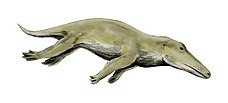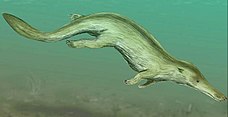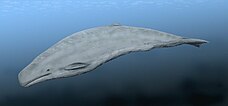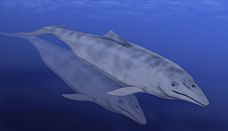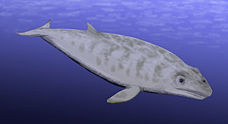Evolution of cetaceans
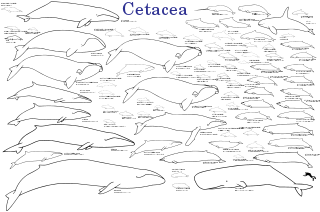
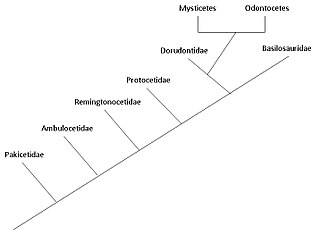
The evolution of cetaceans is thought to have begun in the
The two modern
Early evolution

The aquatic lifestyle of cetaceans first began in the
The molecular data are supported by the discovery of Pakicetus, the earliest
Indohyus
Indohyus was a small chevrotain-like animal that lived about 48 million years ago in what is now Kashmir.[12] It belongs to the artiodactyl family Raoellidae, which is believed to be the closest sister group of Cetacea. Indohyus is identified as an artiodactyl because it has two trochlea hinges, a trait unique to artiodactyls.[7] Approximately the size of a raccoon or domestic cat, this omnivorous creature shared some traits of modern whales, most notably the involucrum, a bone growth pattern which is the diagnostic characteristic of any cetacean; this is not found in any other species.[1] It also showed signs of adaptations to aquatic life, including dense limb bones that reduce buoyancy so that they could stay underwater, which are similar to the adaptations found in modern aquatic mammals such as the hippopotamus.[10][13] This suggests a similar survival strategy to the African chevrotain or water chevrotain which, when threatened by a bird of prey, dives into water and hides beneath the surface for up to four minutes.[14]
The first fossils of the Indohyus were unearthed by Indian geologist A. Ranga Rao.[15] He discovered a few teeth and a jawbone amongst rocks that he had collected. After his death, his widow Leelavathi Rao donated the rocks to professor Hans Thewissen. His technician accidentally broke open a couple of the donated rocks and discovered additional Indohyus fossils.
Pakicetidae
The pakicetids were
Pakicetids are classified as cetaceans mainly due to the structure of the
Pakicetids have long thin legs, with relatively short hands and feet which suggest that they were poor swimmers.
Ambulocetidae
Ambulocetus, which lived about 49 million years ago, was discovered in Pakistan in 1994. They were vaguely crocodile-like mammals, possessing large brevirostrine jaws. In the Eocene, ambulocetids inhabited the bays and estuaries of the Tethys Sea in northern Pakistan. The fossils of ambulocetids are always found in near-shore shallow marine deposits associated with abundant marine plant fossils and littoral mollusks.[1] Although they are found only in marine deposits, their oxygen isotope values indicate that they consumed a range of water with different degrees of salinity, with some specimens having no evidence of sea water consumption and others that did not ingest fresh water at the time when their teeth were fossilized. It is clear that ambulocetids tolerated a wide range of salt concentrations. Hence, ambulocetids represent a transition phase of cetacean ancestors between fresh water and marine habitat.[18]
The mandibular foramen in ambulocetids had increased in size, which indicates that a fat pad was likely to be housed in the lower jaw. In modern toothed whales, this fat pad in the mandibular foramen extends posteriorly to the middle ear. This allows sounds to be received in the lower jaw, and then transmitted through the fat pad to the middle ear. Similar to pakicetids, the orbits of ambulocetids are on the top of the skull, but they face more laterally than in pakicetids.[18]
Ambulocetids had relatively long limbs with particularly strong hind legs, and they retained a tail with no sign of a fluke.[17] The hindlimb structure of Ambulocetids shows that their ability to engage in terrestrial locomotion was significantly limited compared to that of contemporary terrestrial mammals, and likely did not come to land at all. The skeletal structures of the knee and ankle indicates that the motion of the hindlimbs was restricted into one plane. This suggests that, on land, propulsion of the hindlimbs was powered by the extension of dorsal muscles.[24] They probably swam by pelvic paddling (a way of swimming which mainly utilizes their hind limbs to generate propulsion in water) and caudal undulation (a way of swimming which uses the undulations of the vertebral column to generate force for movements), as otters, seals and modern cetaceans do.[25] This is an intermediate stage in the evolution of cetacean locomotion, as modern cetaceans swim by caudal oscillation (a way of swimming similar to caudal undulation, but is more energy efficient).[18]
A recent study suggests that ambulocetids were fully aquatic like modern cetaceans, possessing a similar thoracic morphology and being unable to support their weight on land. This suggests that complete abandonment of the land evolved much earlier among cetaceans than previously thought. However the scientists involved in the study cautioned that the study was limited by a lack of information on the exact density of the bone, the location of the centre of mass, and the reliance of false ribs for thoracic support. [26]
Remingtonocetidae
Remingtonocetids lived in the Middle-Eocene in South Asia, about 49 to 43 million years ago.[27] Compared to family Pakicetidae and Ambulocetidae, Remingtonocetidae was a diverse family found in north and central Pakistan and western India. Remingtonocetids were also found in shallow marine deposits, but they were obviously more aquatic than ambulocetidae. This is demonstrated by the recovery of their fossils from a variety of coastal marine environments, including near-shore and lagoonal deposits.[1] According to stable oxygen isotopes analysis, most remingtonocetids did not ingest fresh water, and had hence lost their dependency on fresh water relatively soon after their origin.[18]
The orbits of remingtonocetids faced laterally and were small. This suggests that vision was not an important sense for them. The nasal opening, which eventually becomes the blowhole in modern cetaceans, was located near the tip of the
Compared to ambulocetids, remingtonocetids had relatively short limbs.[18] Based on their skeletal remains, remingtonocetids were probably amphibious cetaceans that were well adapted to swimming, and likely to swim by caudal undulation only.[1]
Protocetidae
The protocetids form a diverse and heterogeneous group known from Asia, Europe, Africa, and North America. They lived in the Eocene, approximately 48 to 35 million years ago. The fossil remains of protocetids were uncovered from coastal and lagoonal facies in South Asia; unlike previous cetacean families, their fossils uncovered from Africa and North America also include open marine forms.[1] They were probably amphibious, but more aquatic compared to remingtonocetids.[27] Protocetids were the first cetaceans to leave the Indian subcontinent and disperse to all shallow subtropical oceans of the world.[18]
There were many genera among the family Protocetidae. There were different degrees of aquatic adaptations in this group, with some able to support their weight on land, and others not.
Unlike remingtonocetids and ambulocetids, protocetids have large orbits which are oriented laterally. Increasingly lateral-facing eyes might be used to observe underwater prey, and are similar to the eyes of modern cetaceans. Furthermore, the nasal openings were large and were halfway up the snout. The great variety of teeth suggests diverse feeding modes in protocetids.[27] In both remingtonocetids and protocetids, the size of the mandibular foramen had increased.
Some protocetids had short, wide fore- and hindlimbs that were likely to have been used in swimming, but the limbs gave a slow and cumbersome locomotion on land.[18] It is possible that some protocetids had flukes. However, it is clear that they were adapted even further to an aquatic life-style. In Rodhocetus, for example, the sacrum (a bone that, in land-mammals, is a fusion of five vertebrae that connects the pelvis with the rest of the vertebral column) was divided into loose vertebrae. However, the pelvis was still connected to one of the sacral vertebrae. The ungulate ancestry of these archaeocetes is still underlined by characteristics like the presence of hooves at the ends of the toes in Rodhocetus.[31]
The foot structure of Rodhocetus shows that protocetids were predominantly aquatic. A 2001 study done by Gingerich et al. hypothesized that Rodhocetus locomoted in the oceanic environment similarly to how ambulocetids pelvic paddling, which was supplemented by caudal undulation. Terrestrial locomotion of Rodhocetus was very limited due to their hindlimb structure. It is thought that they moved in a way similar to how eared seals move on land, by rotating their hind flippers forward and underneath their body.[32]
Basilosauridae

Basilosaurids and dorudontines lived together in the late Eocene around 41 to 33.9 million years ago, and are the oldest known obligate aquatic cetaceans.[22] They were fully recognizable whales which lived entirely in the ocean. This is supported by their fossils usually found in deposits indicative of fully marine environments, lacking any freshwater influx.[1] They were probably distributed throughout the tropical and subtropical seas of the world. Basilosaurids are commonly found in association with dorudontines, and were closely related to one another.[18] The fossilised stomach contents in one basilosaurid indicates that it ate fish.[1]
Although they look very much like modern cetaceans, basilosaurids lacked the '
Both basilosaurids have skeletons that are immediately recognizable as cetaceans. A basilosaurid was as big as the larger modern whales, with genera like Basilosaurus reaching lengths of up to 60 ft (18 m) long; dorudontines were smaller, with genera like Dorudon reaching about 15 ft (4.6 m) long. The large size of basilosaurids is due to the extreme elongation of their lumbar vertebrae. They had a tail fluke, but their body proportions suggest that they swam by caudal undulation and that the fluke was not used for propulsion.[1][33] In contrast, dorudontines had a shorter but powerful vertebral column. They too had a fluke and, unlike basilosaurids, they probably swam similarly to modern cetaceans, by using caudal oscillations.[18] The forelimbs of basilosaurids were probably flipper-shaped, and the external hind limbs were tiny and were certainly not involved in locomotion.[1] Their fingers, however, retained the mobile joints of their ambulocetid relatives. The two tiny but well-formed hind legs of basilosaurids were probably used as claspers when mating. The pelvic bones associated with these hind limbs were not connected to the vertebral column as they were in protocetids. Essentially, any sacral vertebrae can no longer be clearly distinguished from the other vertebrae.[1][34]
Both basilosaurids and dorudontines are relatively closely related to modern cetaceans, which belong to parvorders
Evolution of modern cetaceans
Baleen whales
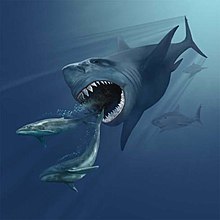
All modern baleen whales or mysticetes are filter-feeders which have baleen in place of teeth, though the exact means by which baleen is used differs among species (gulp-feeding within balaenopterids, skim-feeding within balaenids, and bottom plowing within eschrichtiids). The first members of both groups appeared during the middle Miocene. Filter feeding is very beneficial as it allows baleen whales to efficiently gain huge energy resources, which makes the large body size in modern varieties possible.[35] The development of filter feeding may have been a result of worldwide environmental change and physical changes in the oceans. A large-scale change in ocean current and temperature could have contributed to the radiation of modern mysticetes.[36] The earlier varieties of baleen whales, or "archaeomysticetes", such as Janjucetus and Mammalodon had very little baleen and relied mainly on their teeth.[37]
There is also evidence of a genetic component of the evolution of toothless whales. Multiple mutations have been identified in genes related to the production of enamel in modern baleen whales.[38] These are primarily insertion/deletion mutations that result in premature stop codons.[38] It is hypothesized that these mutations occurred in cetaceans already possessing preliminary baleen structures, leading to the pseudogenization of a "genetic toolkit" for enamel production.[39] Recent research has also indicated that the development of baleen and the loss of enamel-capped teeth both occurred once, and both occurred on the mysticete stem branch.
Generally it is speculated the four modern mysticete families have separate origins among the
Toothed whales
The adaptation of
The first oceanic dolphins such as
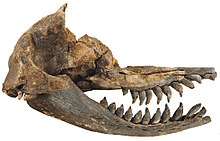
Ancient sperm whales differ from modern sperm whales in tooth count and the shape of the face and jaws. For example, Scaldicetus had a tapered rostrum. Genera from the Oligocene and Miocene had teeth in their upper jaws. These anatomical differences suggest that these ancient species may not have necessarily been deep-sea squid hunters like the modern sperm whale, but that some genera mainly ate fish.[27][56] Contrary to modern sperm whales, most ancient sperm whales were built to hunt whales. Livyatan had a short and wide rostrum measuring 10 feet (3.0 m) across, which gave the whale the ability to inflict major damage on large struggling prey, such as other early whales. Species like these are collectively known as killer sperm whales or macroraptorial sperm whales.[56][57]
Skeletal evolution
Modern cetaceans have internal, rudimentary hind limbs, such as reduced femurs, fibulas, and tibias, and a

Limblessness in cetaceans does not represent a regression of fully formed limbs nor the absence of limb bud initiation, but rather arrest of limb bud development.[62] Limb buds develop normally in cetacean embryos.[10][63] Limb buds progress to the condensation phase of early skeletogenesis, where nerves grow into the limb bud and the apical ectodermal ridge (AER), a structure that ensures proper limb development, appears functional.[62][63] Occasionally, the genes that code for longer extremities cause a modern whale to develop miniature legs (atavism).[64]
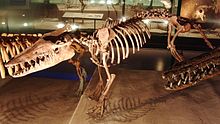
Pakicetus had a pelvic bone most similar to that of terrestrial mammals. In later species, such as Basilosaurus, the pelvic bone, no longer attached to the vertebrae and the
Early archaeocetes such as
Radiation events
There are three major radiation events that mark diversification and speciation in the evolutionary history of Cetacea. The first occurred around the middle Eocene (40 Mya) when these early cetaceans abandoned riverine and shallow coastal habitats, setting the scene for Protocetidae – the first fully marine cetacean.[1] With the oceans and its nutrients at their disposal, rapidly diversifying protocetids were also responsible for the first major geographic expansion, dispersing throughout North Africa, Europe, and North America.[19] The second of three major radiation events occurred near the start of the Oligocene (~34 Mya) when Neoceti diverged from Basilosauridae.[5] This radiation event concurrently occurs with the breakup of Gondwana and the opening of the Southern Ocean, wildly changing ocean ecosystems, productivity, and temperature gradients.[71] The timing of this second radiation event is not coincidental, as the following diversification of cetaceans was likely due to new ecological opportunities the change in oceans gave them.[72] The final major radiation event, occurring throughout the middle Miocene and into the Pliocene (12 Mya to 2 Mya), was not due to a specific event but is associated with widespread generic expansion of odontocetes and mysticetes.[19][71] Some modern genera of cetaceans began to emerge, including Balaenoptera, a genus of rorquals that includes the blue whale.[19][71] Delphinidae, ocean dolphins, also arose during this radiation event in the late Miocene.[71]
Ongoing evolution
Culture
Culture is group-specific behavior transferred by social learning. Tool use to aid with foraging is one example. Whether or not a dolphin uses a tool affects its eating behavior, which causes differences in diet. Also, using a tool allows a new niche and new prey to open up for that particular dolphin. Due to these differences, fitness levels change within the dolphins of a population, which further causes evolution to occur in the long run.[74] Culture and social networks have played a large role in the evolution of modern cetaceans, as concluded in studies showing dolphins preferring mates with the same socially learned behaviors, and humpback whales using songs between breeding areas. For dolphins particularly, the largest non-genetic effects on their evolution are due to culture and social structure.[75]
Based on a 2014 study, the population of
Researchers in a 2014 study in Shark Bay found the fatty acid analyses between the West and East Gulf populations to differ, which is due to the two areas having different food sources. However, when comparing data from within the West Gulf, the spongers vs. the nonspongers in the deep channels had very different fatty acid results even though they are in the same habitat. Nonspongers from deep and shallow channels had similar data. This suggests that sponging was the cause of the different data and not the deep vs. shallow channels. Sponging opened up a new niche for the dolphins and allowed them access to new prey, which caused long-term dietary changes. By producing different food sources within a population, there is less intrapopulation competition for resources, showing character displacement. As a result, the carrying capacity increases since the entire population does not depend on one food source. The fitness levels within the population also change, thus allowing this culture to evolve.[76]
Social structure
Social structure forms groups with individuals that interact with one another, and this allows for cultural traits to emerge, exchange, and evolve. This relationship is especially seen in the bottlenose dolphin populations in southwestern Australia, which have been known to beg for food from fishermen. This begging behavior was spread through the population due to individual (dolphins spending time around boats) and social (dolphins spending time with other dolphins who express begging behavior) learning.[74]
Culture can, however, impact social structure by causing behavior matching and assortive mating. Individuals within a certain culture are more likely to mate with individuals using the same behaviors rather than a random individual, thus influencing social groups and structure. For example, the spongers of Shark Bay preferentially stick with other spongers.[74] Also, some bottlenose dolphins in Moreton Bay, Australia followed prawn trawlers to feed on their debris, while other dolphins in the same population did not. The dolphins preferentially associated with individuals with same behavior even though they all lived in the same habitat. Later on, prawn trawlers were no longer present, and the dolphins integrated into one social network after a couple of years.[74]
Social networks can still affect and cause evolution on their own by impending fitness differences on individuals.[77] According to a 2012 study, male calves had a lower survival rate if they had stronger bonds with juvenile males. However, when other age and sex classes were tested, their survival rate did not significantly change.[78] This suggests that juvenile males impose a social stress on their younger counterparts. In fact, it has been documented that juvenile males commonly perform acts of aggression, dominance, and intimidation against the male calves.[78] According to a 2010 study, certain populations of Shark Bay dolphins had varying levels of fitness and calf success. This is either due to social learning (whether or not the mother passed on her knowledge of reproductive ability to the calves), or due to the strong association between mother dolphins in the population; by sticking in a group, an individual mother does not need to be as vigilant all the time for predators.[77]
Genetic studies conducted on Clymene dolphins (Stenella clymene) focused on their natural histories, and the results show that the origin of the species was actually an outcome of hybrid speciation.[79][80] Hybridization between spinner dolphins (Stenella longirostris) and striped dolphins (Stenella coeruleoalba) in the North Atlantic was caused by constant habitat sharing of the two species. Relationships between these three species had been speculated according to notable resemblances between anatomies of the Clymene and the spinner dolphins, resulting in the former being regarded as subspecies of the latter until 1981,[81] and the possibility of the Clymene dolphin as a hybrid between the spinner and the striped dolphins have come to question based on anatomical and behavioral similarities between these two species.[82]
Environmental factors
Genome sequences done in 2013 revealed that the
The European population of common dolphins (Delphinus delphis) in the Mediterranean have differentiated into two types: eastern and western. According to a 2012 study, this seems to be due to a recent bottleneck as well, which drastically decreased the size of the eastern Mediterranean population. Also, the lack of population structure between the western and eastern regions seems contradictory of the distinct population structures between other regions of dolphins.[84] Even though the dolphins in the Mediterranean area had no physical barrier between their regions, they still differentiated into two types due to ecology and biology. Therefore, the differences between the eastern and western dolphins most likely stems from highly specialized niche choice rather than just physical barriers. Through this, environment plays a large role in the differentiation and evolution of this dolphin species.[85]
The divergence and speciation within bottlenose dolphins has been largely due to climate and environmental changes over history. According to research, the divisions within the genus correlate with periods of rapid climate change. For example, the changing temperatures could cause the coast landscape to change, niches to empty up, and opportunities for separation to appear.[86] In the Northeast Atlantic, specifically, genetic evidence suggests that the bottlenose dolphins have differentiated into coastal and pelagic types. Divergence seems most likely due to a founding event where a large group separated. Following this event, the separate groups adapted accordingly and formed their own niche specializations and social structures. These differences caused the two groups to diverge and to remain separated.[87]
Two endemic, distinctive types of
See also
- Aquatic adaptation
- Evolution of mammals
- Evolution of sirenians
- List of extinct cetaceans
- Transitional form
References
- ^ .
- ^ Davis, R. W. 2019. Return to the Sea: The Evolution of Marine Mammals. Pages 7–27 in R. W. Davis, ed. Marine Mammals: Adaptations for an Aquatic Life. Springer International Publishing, New York.
- ^ Geisler, J. H., and M. D. Uhen. 2005. Phylogenetic relationships of extinct Cetartiodactyls: results of simultaneous analyses of molecular, morphological, and stratigraphic data. Journal of Mammalian Evolution 12:145–160.
- ^ Berta, A., J. L. Sumich, and K. M. Kovacs. 2005. Marine Mammals: Evolutionary Biology. Elsevier, Amsterdam.
- ^ a b Thewissen, J. G. M., L. N. Cooper, J. C. George, and S. Bajpai. 2009. From land to water: the origin of whales, dolphins, and porpoises. Evolution: Education and Outreach 2:272–288.
- PMID 11416211.
- ^ S2CID 4416444.
- ^ Roach, John (2011). "Oldest Antarctic Whale Found; Shows Fast Evolution". Archived from the original on 18 November 2011. Retrieved 3 January 2018.
- ^ Hong-Yan, Gao; Xi-Jun, Ni (2015). "Diverse stem cetaceans and their phylogenetic relationships with mesonychids and artiodactyls" (PDF). Vertebrata PalAsiatica. 53 (2): 165.
- ^ a b c University of California, Berkeley (7 February 2005). "UC Berkeley, French Scientists Find Missing Link Between The Whale And Its Closest Relative, The Hippo". Retrieved 21 December 2007.
{{cite newsgroup}}: CS1 maint: numeric names: authors list (link) - ^ ISBN 978-0-486-29371-4.
- ^ a b Northeastern Ohio Universities Colleges of Medicine and Pharmacy (2007). "Whales Descended From Tiny Deer-like Ancestors". Retrieved 21 December 2007.
- ^ University of Michigan (2001). "New Fossils Suggest Whales And Hippos Are Close Kin". Retrieved 21 December 2007.
- ^ Ian Sample (2007). "Whales may be descended from a small deer-like animal". Retrieved 21 December 2007.
- ISSN 0261-3077. Retrieved 16 May 2020.
- ^ Gingerich, Philip D.; Russell, D. E. (1981). "Pakicetus inachus, a new archaeocete (Mammalia, Cetacea) from the early-middle Eocene Kuldana Formation of Kohat (Pakistan)". Museum of Paleontology. 25: 235–246.
- ^ a b Castro, Peter; Huber, Michael E. (2003). Marine Biology (4 ed). McGraw-Hill.
- ^ ISSN 0006-3568.
- ^ .
- ^ S2CID 4372872.
- S2CID 84127292.
- ^ S2CID 4416684.
- S2CID 4416684.
- S2CID 20604393.
- S2CID 51685113.
- PMID 27396988.
- ^ .
- ^ S2CID 4331789.
- PMID 30955933.
- PMID 19194487.
- ISBN 978-1-4899-0161-3.
- S2CID 21441797.
- PMID 25714394.
- ^ N. Wilford, John (1990). "Whales' hind feet show up in fossils". Retrieved 1 March 2016.
- PMID 18266181.
- PMID 18266181.
- PMID 21849306.
- ^ PMID 18266181.
- PMID 20861053.
- PMID 23256199.
- .
- ISSN 0024-4066.
- PMID 31039728.
- PMID 28539520.
- PMID 20525610.
- S2CID 30549019.)
{{cite journal}}: CS1 maint: numeric names: authors list (link - S2CID 4372872.)
{{cite journal}}: CS1 maint: numeric names: authors list (link - JSTOR 2412507.
- .
- ISBN 978-111-856127-0.
- PMID 24631245.
- ISBN 978-0-87196-871-5.
- ASIN B0006YRTU4.
- JSTOR 2412508.
- ISBN 978-0-12-373553-9.
- ^ .
- ^ Brian Switek. "Sperm whales: a long and vicious history". Retrieved 12 August 2015.
- ^ a b Giovanni Bianucci; Klaas Post; Olivier Lambert (2008). "Beaked whale mysteries revealed by seafloor fossils trawled off South Africa". University of Pisa, Natural History Museum of Rotterdam, Royal Institute of Natural Sciences of Belgium. 104 (3–4): 140–142.
- S2CID 129787505.
- ^ .
- S2CID 4416684.
- ^ S2CID 8448387.
- ^ PMID 16717186.
- S2CID 8448387.
- ^ S2CID 15055515.
- PMID 25186496.
- S2CID 31047933.
- PMID 15297745.
- ISBN 978-1-4200-7763-6.
- PMID 25760328.
- ^ ISBN 978-0-12-804327-1, retrieved 13 November 2022
- S2CID 21680283.
- PMID 21799801.
- ^ PMID 23569288.
- PMID 23569288.
- ^ PMID 24759862.
- ^ PMID 21041638.
- ^ PMID 23077627.
- PMID 24421898.
- ^ Choi, Charles (2014). "DNA Discovery Reveals Surprising Dolphin Origins". Archived from the original on 12 January 2014. Retrieved 2 January 2016.
- JSTOR 1380405.
- ^ Q. Choi, Charles (2014). "DNA Discovery Reveals Surprising Dolphin Origins". National Geographic. Archived from the original on 12 January 2014. Retrieved 20 January 2016.
- PMID 24169659.
- S2CID 7205948.
- . Retrieved 19 November 2021.
- PMID 23929779.
- S2CID 22266293.
- .
- ^ Amano M. (2012). "みちのくの海のイルカたち(特集 みちのくの海と水族館の海棲哺乳類)". Isana 56: 60–65. Retrieved 9 March 2017.
- ^ Hidaka T. Kasuya T. Izawa K. Kawamichi T. 1996. The encyclopaedia of animals in Japan (2) – Mammals 2.
ISBN 9784582545524 (9784582545517) (4582545521). Heibonsha
External links
For a review of whale evolution, see Uhen, M. D. (2010). "The Origin(s) of Whales". Annual Review of Earth and Planetary Sciences. 38 (1): 189–219. .
- Timeline of Whale Evolution - Smithsonian Ocean Portal
- Cetacean Paleobiology – University of Bristol
- BBC: Whale's evolution
- BBC: Whale Evolution – The Fossil Evidence
- Hooking Leviathan by Its Past by Stephen Jay Gould
- Research on the Origin and Early Evolution of Whales (Cetacea), Gingerich, P.D., University of Michigan
- Pakicetus inachus, a new archaeocete (Mammalia, Cetacea) from the early-middle Eocene Kuldana Formation of Kohat (Pakistan). Gingerich, P.D., 1981, Museum of Paleontology, The University of Michigan
- Skeletons of terrestrial cetaceans and the relationship of whales to artiodactyls, Nature 413, 277–281 (20 September 2001), J. G. M. Thewissen, E. M. Williams, L. J. Roe and S. T. Hussain
- Evolution of Whales segment from the Whales Tohorā Exhibition Minisite of the Museum of New Zealand Te Papa Tongarewa



